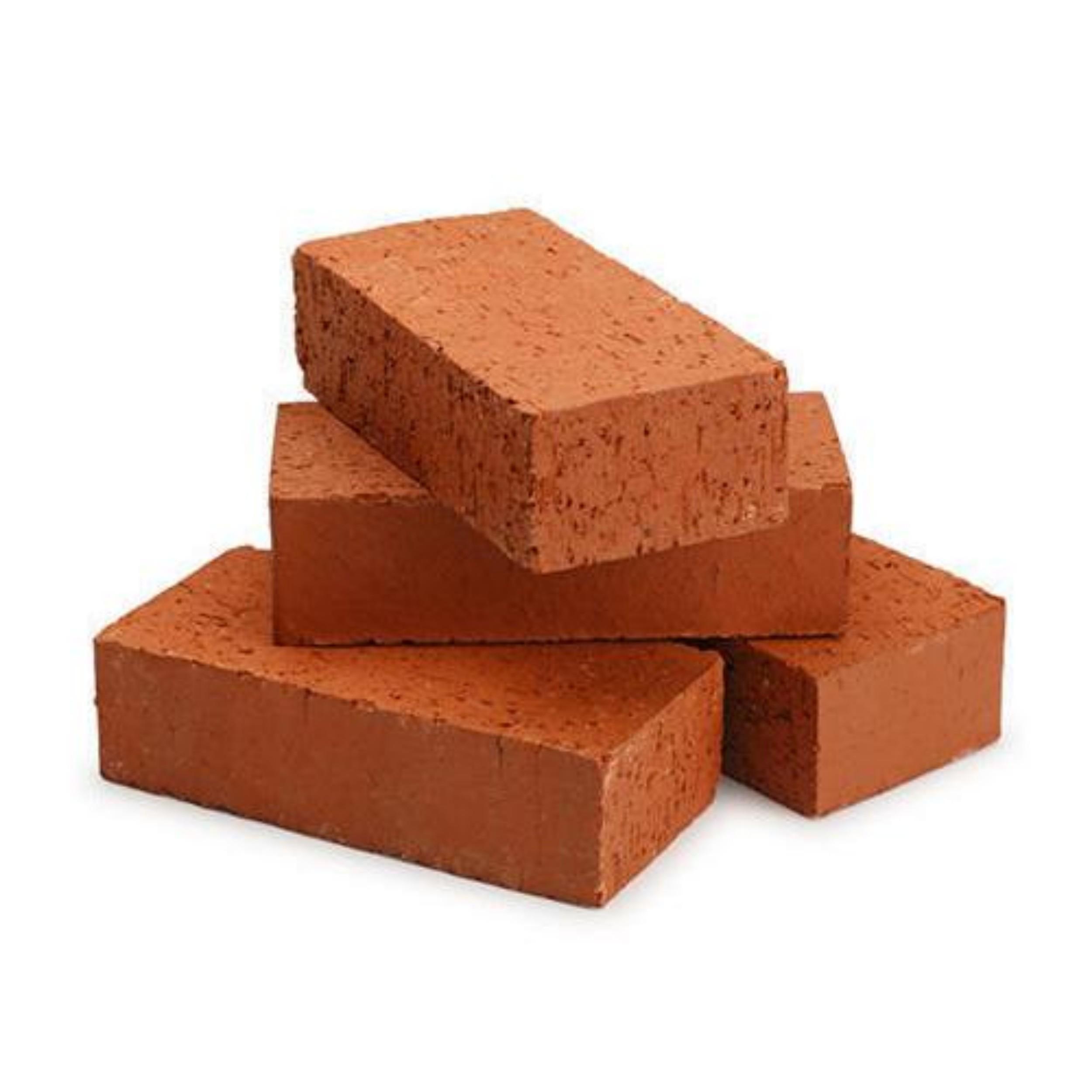Red Bricks
Red bricks are a popular building material known for their durability, strength, and aesthetic appeal. They are primarily made from clay or shale and are called "red bricks" due to the iron oxide (rust) that gives them their distinctive red color. The process of making red bricks involves mixing the raw materials, molding the bricks, drying them to remove moisture, and then firing them in a kiln at high temperatures to harden them.

Manufacturing Process of Red Bricks
Preparation of Clay
The first step involves extracting clay, usually from a clay pit. The clay is then processed to remove impurities, such as stones or organic matter. It's mixed with water to achieve the correct consistency.
Molding
The clay is shaped into bricks using either a manual or mechanical process. In manual molding, workers use molds to shape the bricks by hand. Mechanical molding involves using machines to extrude or press the clay into brick shapes.
Drying
The formed bricks are left to dry either in the open air or in drying chambers. This step reduces the moisture content and prepares the bricks for firing. Proper drying is crucial to prevent cracking during the firing process.
Firing
The dried bricks are loaded into a kiln and fired at temperatures ranging from 900°C to 1200°C. The firing process vitrifies the clay, making the bricks hard and durable. The exact temperature and duration of firing depend on the type of clay and desired properties of the final product.
Cooling
After firing, the bricks are slowly cooled to room temperature. Rapid cooling can cause cracking or other defects.
Key Properties and Considerations
Color Variability
While typically red, the exact shade can vary from light pink to deep red, depending on the clay composition and firing conditions. Additives can also be used to alter the color.
Texture and Finish
Red bricks can have various textures, from smooth to rugged, depending on the molding process and the materials used. Some bricks are designed with specific textures for aesthetic or functional purposes, such as improved grip in paving applications.
Dimensional Stability
Properly manufactured red bricks have excellent dimensional stability, meaning they maintain their shape over time without significant expansion or contraction. This stability is crucial for structural integrity and long-term performance.
Sound Insulation
Due to their density and mass, red bricks provide good sound insulation, contributing to quieter indoor environments.
Maintenance and Repair
Red bricks require minimal maintenance, mainly occasional cleaning to remove dirt or moss. Damaged bricks can be replaced individually without affecting the overall structure
Sustainability and Recycling
Red bricks are considered sustainable due to their natural composition and longevity. They can also be recycled or crushed for use in landscaping, road base material, or new construction projects.
When selecting red bricks for a project, it's important to consider all these factors in the context of the project's specific requirements, including structural needs, aesthetic goals, local climate conditions, and sustainability objectives. The timeless appeal and proven durability of red bricks make them a favored choice in both traditional and modern construction projects.
Technical Data for Red Bricks
- Dimensions: The standard size of a red brick is approximately 190 mm (length) x 90 mm (width) x 90 mm (height), but sizes can vary based on the region and manufacturer.
- Weight: A standard red brick weighs about 2.5 to 3 kg, depending on its density and moisture content.
- Compressive Strength: The compressive strength of red bricks typically ranges between 10 MPa to 20 MPa (Mega Pascal). This indicates the maximum load a brick can bear without failure.
- Water Absorption: Red bricks have a water absorption rate of 6% to 12% of their weight. This is an important factor in determining the brick's durability and suitability for various environmental conditions.
- Thermal Conductivity: Red bricks have a thermal conductivity value ranging from 0.6 to 1.0 W/mK (watts per meter Kelvin), making them a good insulator. This property helps in maintaining indoor temperature, making buildings cooler in summer and warmer in winter.
- Fire Resistance: Red bricks are highly fire-resistant due to their manufacturing process. They can withstand high temperatures without losing structural integrity, making them a safe choice for building construction.
- Durability: Red bricks are known for their long-lasting nature. They can withstand harsh weather conditions, including heavy rain, strong winds, and extreme temperatures, without significant damage.
- Eco-friendliness: Being made from natural materials, red bricks are considered environmentally friendly. They can be recycled or crushed for other uses, reducing waste in landfills.
When choosing red bricks for construction, it's important to consider these technical specifications along with the specific requirements of the project, such as aesthetic considerations, local building codes, and environmental factors. Red bricks have been used for centuries in construction due to their strength, durability, and aesthetic appeal, making them a timeless choice for builders and architects.
Key Differences Between Red Bricks and Fly Ash Bricks
Red Bricks
- Material: Made primarily from natural clay and shale.
- Manufacturing Process: Involves mixing, molding, drying, and firing at high temperatures in a kiln.
- Color: Typically red, due to the iron oxide content.
- Weight: Heavier than fly ash bricks.
- Thermal Insulation: Offers moderate thermal insulation.
- Water Absorption: Higher water absorption rate than fly ash bricks.
- Environmental Impact: Produces more CO2 during manufacturing due to the firing process.
- Strength: Compressive strength varies, but generally lower than that of fly ash bricks.
- Cost: Can be more expensive in areas where clay is not readily available.
- Use: Widely used for centuries in all types of construction.
Fly Ash Bricks
- Material: Made from fly ash (a byproduct of coal combustion), water, and an alkaline activator, often with a quicklime or cement binder.
- Manufacturing Process: Involves mixing, molding, and curing under high pressure and temperature or at room temperature in some processes.
- Color: Generally uniform gray color.
- Weight: Lighter than red bricks, which can reduce structural load and transport costs.
- Thermal Insulation: Offers better thermal insulation than red bricks, contributing to energy-efficient buildings.
- Water Absorption: Lower water absorption rate, making them more resistant to moisture and less prone to efflorescence.
- Environmental Impact: Considered more environmentally friendly due to the recycling of industrial waste (fly ash) and lower energy requirements for production.
- Strength: Typically higher compressive strength compared to red bricks, making them suitable for high-load bearing applications.
- Cost: Often less expensive than red bricks, especially where fly ash is readily available.
- Use: Increasingly used in modern construction, especially in regions promoting green building materials.
Choosing Between Red and Fly Ash Bricks
The choice between red bricks and fly ash bricks depends on several factors, including:
- Project Requirements: The structural requirements of the project might dictate the choice. Fly ash bricks, with their higher strength, may be preferred for structures requiring greater load-bearing capacity.
- Environmental Considerations: For projects aiming for environmental sustainability, fly ash bricks are the superior choice due to their lower carbon footprint and the recycling of industrial waste.
- Availability and Cost: The local availability of materials can significantly influence cost and availability. In regions where fly ash is abundant, fly ash bricks might be more economical.
- Aesthetic Preferences: The traditional appearance of red bricks might be preferred for certain architectural styles, while the uniform appearance of fly ash bricks might be desirable for modern designs.
- Insulation Needs: For buildings where thermal efficiency is a priority, fly ash bricks might be the better option due to their superior insulation properties.
Ultimately, the decision between red bricks and fly ash bricks will depend on the specific needs of the construction project, including structural requirements, budget constraints, environmental impact considerations, and aesthetic preferences.






